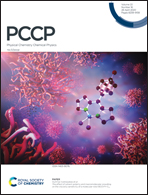Precision measurement of the fundamental vibrational frequencies of tritium-bearing hydrogen molecules: T2, DT, HT
Abstract
High-resolution coherent Raman spectroscopic measurements of all three tritium-containing molecular hydrogen isotopologues T2, DT and HT were performed to determine the ground electronic state fundamental Q-branch (v = 0 → 1, ΔJ = 0) transition frequencies at accuracies of 0.0005 cm−1. An over hundred-fold improvement in accuracy over previous experiments allows the comparison with the latest ab initio calculations in the framework of non-adiabatic perturbation theory including nonrelativisitic, relativisitic and QED contributions. Excellent agreement is found between experiment and theory, thus providing a verification of the validity of the NAPT-framework for these tritiated species. While the transition frequencies were corrected for ac-Stark shifts, the contributions of non-resonant background as well as quantum interference effects between resonant features in the nonlinear spectroscopy were quantitatively investigated, also leading to corrections to the transition frequencies. Methods of saturated CARS with the observation of Lamb dips, as well as the use of continuous-wave radiation for the Stokes frequency were explored, that might pave the way for future higher-accuracy CARS measurements.



 Please wait while we load your content...
Please wait while we load your content...